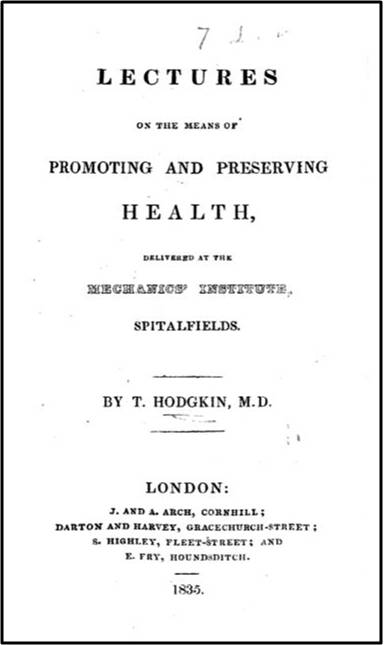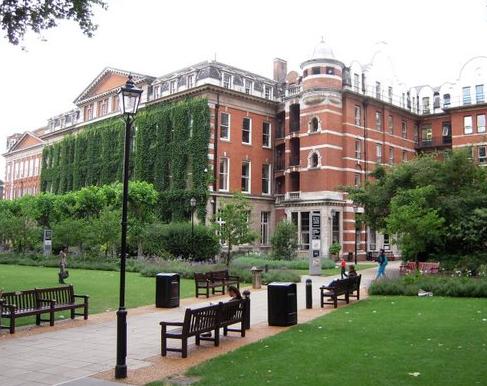 Thomas Hodgkin an English physician and pathologist, was admitted to St Thomas’s and Guy’s Medical School in 1819. He worked as personal physician before finding a position at Guy’s, in 1825, as curator of the museum.
Thomas Hodgkin an English physician and pathologist, was admitted to St Thomas’s and Guy’s Medical School in 1819. He worked as personal physician before finding a position at Guy’s, in 1825, as curator of the museum.
At Guy’s, he created a vast catalogue of specimens in Medical Museum and carried out autopsies, and therefore began to build up a reputation as pathologist.
Hodgkin introduced the first stethoscope to Guy’s Hospital, having encountered it for the first time in Paris, and delivered a lecture on Laennec’s method for its use to the hospital physical society in 1822.
In 1832, he described a pathologic relationship between lymph nodes and the spleen, in his manuscript: “On some Morbid Appearances of the Absorbent Glands and Spleen.” He recognized that, although some of the patients, had co-existent tuberculosis, the firmness and size of the nodes were different. Hodgkin thus recognized the disorder grossly, at autopsy. Subsequent histopathologic examination however, revealed that four of the seven patients described by Hodgkin actually had Hodgkin lymphoma. In fact, this manuscript was barely recognized during his life and not even mentioned in his obituary.
In 1836, he became a founding member of the Senate of the University of London and was admitted as a Fellow of the Royal College of Physicians. He, however, turned down the invitation because of what he considered to be the general injustice concerning the choice of members for the society.
Dr. Hodgkin also described, what later came to be known as, “Key-Hodgkin murmur”: A diastolic murmur of aortic regurgitation with a raspy quality, likened to the sound of “a saw cutting through wood.” Hodgkin correlated the murmur with retroversion of the aortic valve leaflets seen post mortem.

He also advocated the system of student involvement in bedside learning which is still used today. In 1842, he took charge of teaching at St Thomas’s.
Raised as a Quaker, he was imbued with honesty, discipline and concern for the less fortunate. He was a life-long supporter of the abolition of slavery. At the age of 21, he wrote an ‘Essay on the Promotion of Civilization,’ in which he criticized colonists because of whom many North American Indians and other native people died.
 He was a pioneer of preventive medicine. His lecture on the means of promoting and preserving health was published as a book in 1841.
He was a pioneer of preventive medicine. His lecture on the means of promoting and preserving health was published as a book in 1841.

The term “Hodgkin disease” was first endorsed by Dr. Samuel Wilks, who in 1865 published an article honoring and thereby immortalizing Dr. Hodgkin. There was still no histologic description of the disorder!!!
Unfortunately, in the following year, at the age of 67, Dr. Hodgkin died of dysentery on a trip to Palestine.
 Thomas Hodgkin is still remembered today with a blue plaque on his house in Bedford Square, London.
Thomas Hodgkin is still remembered today with a blue plaque on his house in Bedford Square, London.

The King’s School of Medicine’s Hodgkin Building is also named in his honor.
Compiled by Dr. Namrata Kaul
- Stone MJ. Thomas Hodgkin: medical immortal and uncompromising idealist. Proc (Bayl Univ Med Cent). 2005;18(4):368-375.
- Swan HT. Perfecting the World. The Life and Times of Dr Thomas Hodgkin 1798-1866. J Clin Pathol. 1989;42(11):1229-1230.
- Geller SA. Comments on the anniversary of the description of Hodgkin’s disease. J Natl Med Assoc. 1984;76(8):815-817.
- Curator of the Dead. Thomas Hodgkin 1798 1866. Postgrad Med J. 1981;57(674):804-805.
- Wikipedia contributors. (2021, April 6). Thomas Hodgkin. In Wikipedia, The Free Encyclopedia.
Disclaimer: The pictures used in this blog is for education purpose only with no commercial usage.
Last modified: 01/06/2021







